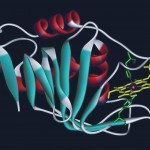Link to Pubmed [PMID] – 29097277
Drug Discov. Today 2018 Feb;23(2):272-285
Protein-protein interactions (PPIs) are well recognized as promising therapeutic targets. Consequently, interfering peptides (IPs) – natural or synthetic peptides capable of interfering with PPIs – are receiving increasing attention. Given their physicochemical characteristics, IPs seem better suited than small molecules to interfere with the large surfaces implicated in PPIs. Progress on peptide administration, stability, biodelivery and safety are also encouraging the interest in peptide drug development. The concept of IPs has been validated for several PPIs, generating great expectations for their therapeutic potential. Here, we describe approaches and methods useful for IPs identification and in silico, physicochemical and biological-based strategies for their design and optimization. Selected promising in-vivo-validated examples are described and advantages, limitations and potential of IPs as therapeutic tools are discussed.


